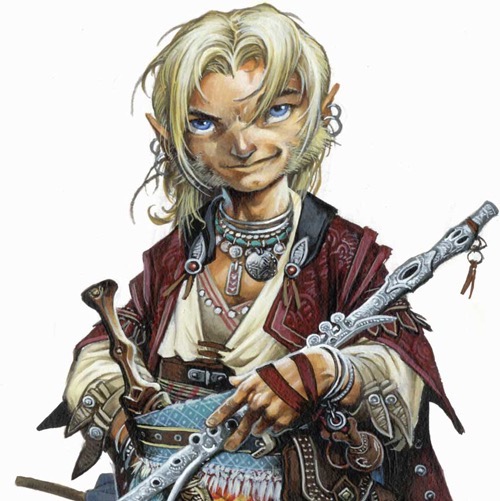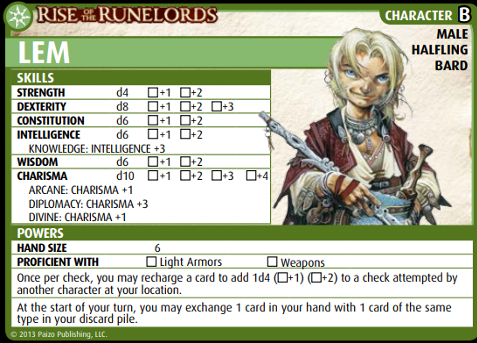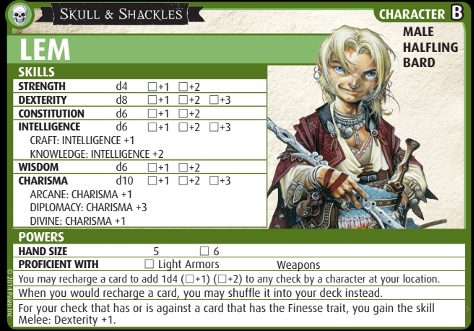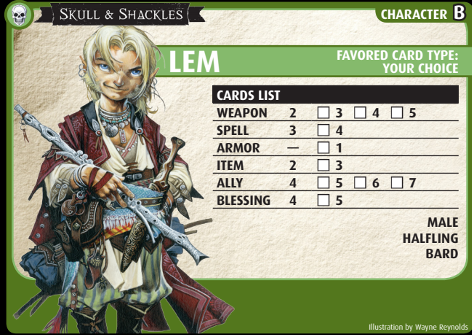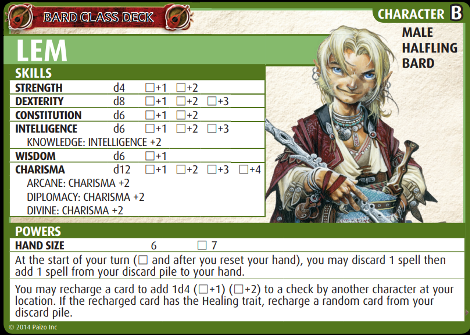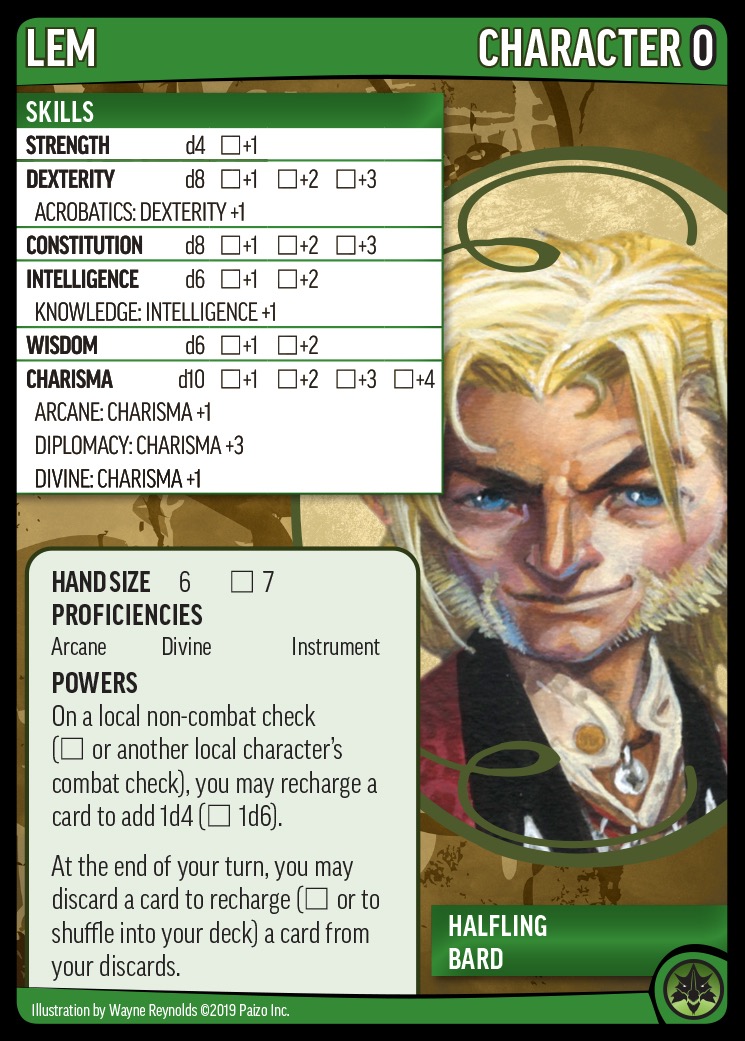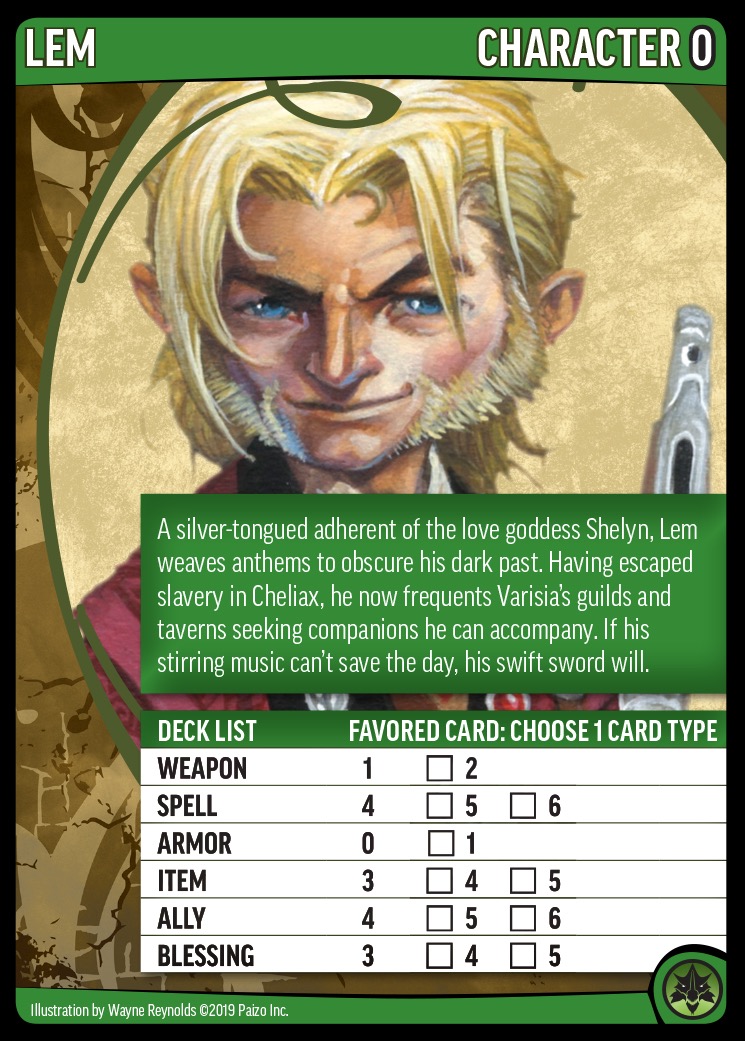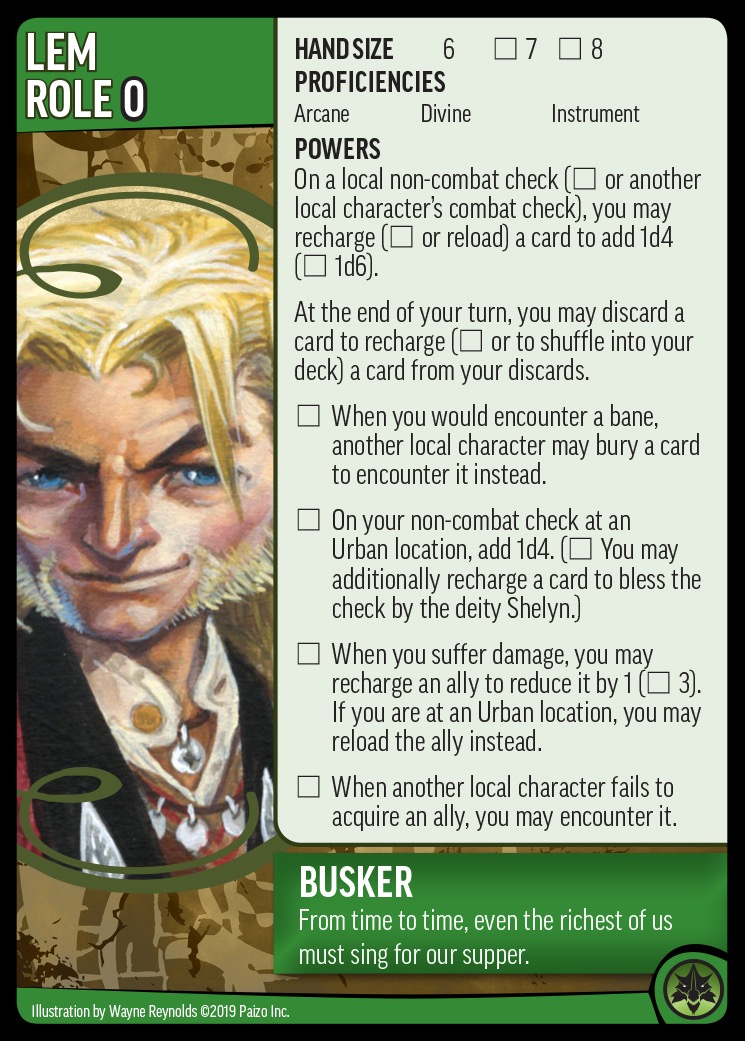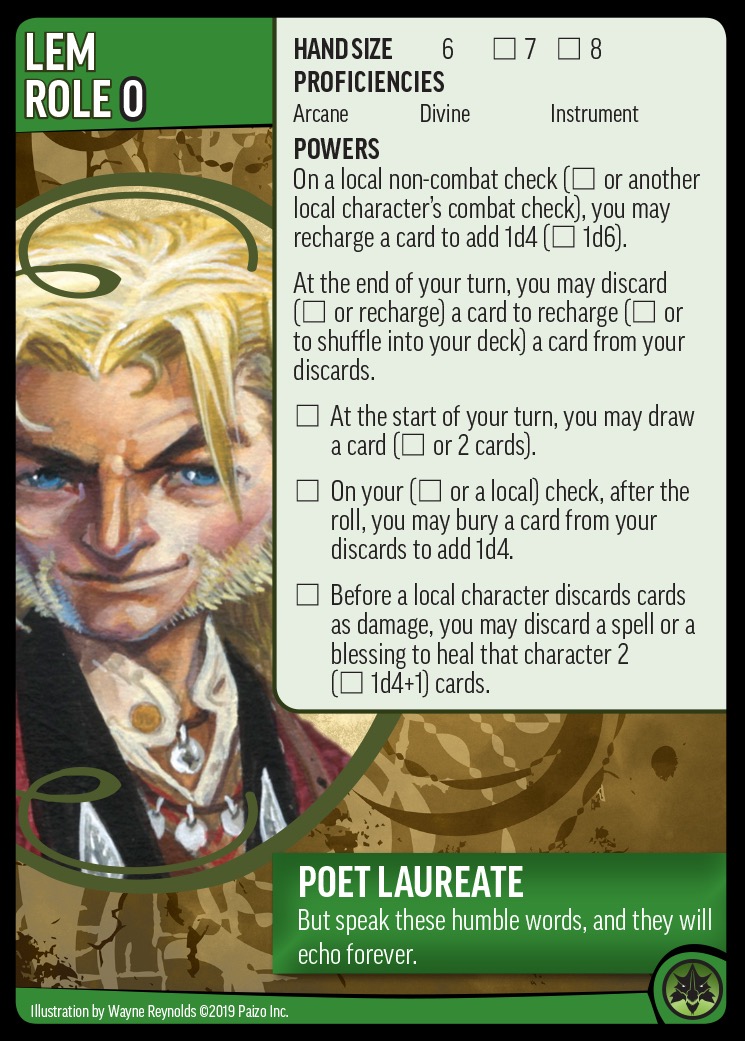Greetings from social-distance land! We’ve been talking about the PACG Core Set characters, including Amiri, Lini, Sajan, Seoni, and Valeros. Today I’m going to talk about friend and boon companion to everyone (unless perhaps your name is Meligaster), the iconic bard Lem.
“Player types” is one of those perennial topics in games and game design, equally as likely to come up in discussion of everything from the first tabletop RPG to the latest AAA console title. Anyone who’s looked into any of the academic, professional, or hobby-level study of games and gaming is likely to have run across at least one attempt to analyze things from the player point of view. Whether it’s Bartle’s Taxonomy, lists of fantasy roleplaying archetypes, 3 well-known player psychographics, or the G/N/S model, both gamers and game designers frequently revisit the (important!) idea that different parts of games are better for different kinds of game experiences. There are many examples of this in PACG, but few stand out as clearly as our awesome halfling helper, Lem.
When we first put together characters for Rise of the Runelords, we knew that we wanted Lem to be good at all sorts of things. As a bard, we wanted him to have a bunch of skills. Mike flat-out refused to let him out the door without Knowledge. Gaby wanted him to be charming and friendly, and Paul and I both wanted to make sure that he was good enough at a variety of things that he could choose to fill any gaps in your particular party. That said, he’s a halfling with a troubled history, so he clearly had some weaknesses. We gave him a large Knowledge bonus, made him a Charisma powerhouse to sometimes rival Seoni, and made sure he had a respectable starting point for Ranged weapons and both Arcane and Divine spellcasting. For his cards list, he has a good spread of card types, letting him dabble in any type while also giving him multiple choices for focus. A large hand size represents his inherent versatility as well as a relative fragility, and the option to get into either weapons or light armor means that he can make use of almost any card you find.
For most people, though, Lem’s powers are really where he shines brightest. With a long list of skills and proficiencies, we knew that we’d need his powers to be relatively concise (a theory that I think we proved, the bad way, in Skull & Shackles). We wanted to emphasize his helpfulness and his versatility, so he got one power for each. The first lets him spend cards from his hand to help other nearby characters at whatever they wanted to do. This power has a cost—putting a card from your hand on the bottom of your deck—which helps make it an interesting choice. Over time, players are likely to realize that this “cost” is often a benefit: if you have cards in your hand that are useful some of the time, but just not right now, you can tuck them away for later use, opening up space to draw new cards without the increased risk of death that comes from just discarding at the end of your turn.
The second power helps create the “just the thing!” moments, since it’s easy for him to swap out a “good, but not right now” card for an especially relevant card from his discard pile. These two powers together let Lem invest in a wide variety of cards, even cards with potentially niche utility. If you find that a particular card isn’t useful right now, you can recharge it to help (first power) or swap it for something more relevant in your discard pile (second power). There’s also an element of mastery at play here—once you get a good handle on the game, you realize that after Lem casts a spell, he might want to recharge it—and thus get it back for “free,” but not immediately. Or he might want to fail to recharge it, so he can swap another spell for it next turn. The latter approach costs him a “hit point” if he’s going to take damage, but it lets him have more control over when he has certain key cards in his hand.
When we were putting together characters for Skull & Shackles, we knew we wanted to change things up a little. Ideally, the characters would feel recognizably themselves, but would also be changed by their experiences at sea. (If you’re familiar with Lem’s history, you probably understand that falling victim to a press gang is especially transformative for him!) While S&S was letting us swap in some new iconics, we all agreed we wanted to bring back Lem in some form: Swashbuckling Lem, Sea Captain Lem, Dread Pirate Lem.
With that in mind, and with apparently wanton disregard for the extra pain we were dropping on the shoulders of the Paizo layout team (To Sonia, Crystal, and Sarah: we apologize. Deeply. Again.), we added Craft to Lem’s list of skills (enabling both Alchemy and ship repair) and gave him our new power for Finesse weapons. This new, tougher Lem swapped a spell out for a weapon, dropped hand size by one, and gained weapon proficiency. His “resourcefulness” power was reduced to let him get back recharged cards more quickly (by shuffling), and his “helping” power was increased to let it apply to himself. It’s still possible to build a super-helpful Lem, but now he can also be a bit more selfish if he wants.
For his Bard Class Deck treatment, we wanted to change the focus again, so we looked more to the magical side of bardishness—but not bardiche-ness. (This also contrasted nicely with the other bards in that deck.) Class Deck Lem got a die bump to the top-end d12 Charisma, pushed his hand size back up to variety-and-fragility, and focused his powers more on spells. His helping power gained a new trick: if he used a Healing card to help others, he also got a little self-healing out of it; everybody wins!
Finally, we come to the new Core Set. We wanted to build a friendly, helpful, “classic” Lem, using our new templates and layout methods. The switch to a vertical layout let us add yet another skill to one of our skill-monkey characters without causing the designers so much pain (again, we’re sorry!); this let us give Lem Acrobatics out of the gate, which makes him seem more like the halfling he is, and also opens up some weapons options without requiring two lines of powers text. Adding Instrument proficiency lets us cleanly represent his facility without recourse to the clumsy “if you have the Bard or Skald trait” wording on each instrument.
His Knowledge and spellcasting skills drop back down to “great” (from “outstanding”), and his first power lets him make up the difference when it counts most. His deck list spreads out evenly while giving him at least one weapon (you might choose a strong Acrobatics-based weapon, or one of Core’s new helpful weapons). Finally, his second power gives him back some of that resourcefulness while avoiding the potential repetitive play concerns I always drone on about, and also moves the processing to the end of the turn (while the next player is likely already starting).
Once you get a couple adventures under his belt, you can choose to focus in either Busker or Poet Laureate. Both roles are meant to reflect the performance aspects of Lem, with Busker offering access to some nifty street-performer tricks for getting by, especially in Urban settings (my favorite being “I’m afraid I cannot fight you… but they can!”). Poet Laureate leans more towards the occult power of Lem’s performances. Also, who doesn’t like drawing cards at the start of their turn?
Chad Brown
Adventure Card Game Lead Developer
